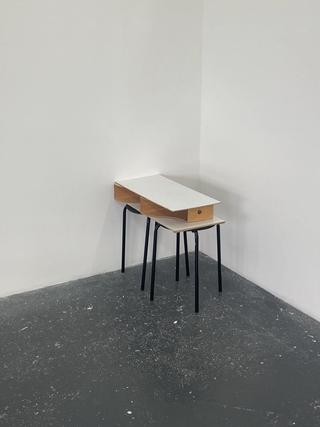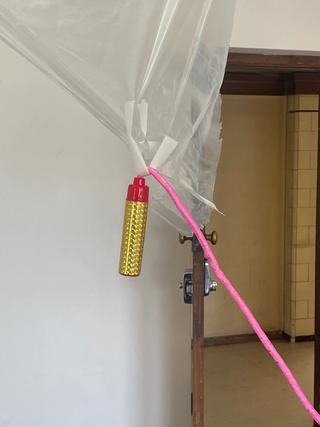

Lingered in a Rude Form
Aaron Ashwood, Lilly Skipper
10–27 Jan 2024
Lilly and Aaron alike, contemplate the studio as an allocated site for modes of intense creative activity and outcomes, understood to be material and resolved. However, the ‘studio’ space does not serve the entirety of their practices. The artists both adhere and oppose the fixed studio site. For both artists’, the re-arrangement of materials within the gallery setting is reliant on the architectural features of the given space, informed by an unexplainable and intuitive feeling surrounding how things sit spatially. Rebelling against the demands to meet an outcome, the artists’ practices are not always tactical or controllable, rather the tactic lies in the arrangement or assemblage of materials. In this collaborative project, Lilly and Aaron uncover a logic in the objects and their installation whilst acknowledging some things cannot be entirely answered, except for what motivates them, the impulse to produce things not entirely understandable. Implaced objects are unconfined and un-dependent of the studio space, in an ongoing flux, rather, responding to location and evolving dependent on site. The artists’ contemplate ‘art as a state of encounter’ (Nicolas Bourriaud, Relational Aesthetics), operating with an intentional degree of randomness wherein practice appears inhabited.
NOTES OF EXCHANGE
Saturday 20 Jan, 2-6pm
Notes of Exchange is an open opportunity to give the artists found materials to work with, at whatever scale and according to no set rules. This will take the form of a day event or ‘opening’ of the studios wherein public participants can drop off or exchange objects with Lilly or Aaron to be included in creative outcomes or object play and consideration. This gesture is an opportunity to explore possibilities with unfamiliar materials beside the artists’ common threads.














































































































































































































































































A collaborative project by Lilly Skipper and Aaron Ashwood investigating the ‘studio’ and its function as a place of production. Contemplating ‘art as a state of encounter’ (Nicolas Bourriaud, Relational Aesthetics) and operating with an intentional degree of randomness wherein practice appears both inhabited and in flux according to site. The artists uncover a logic in the objects and their installation whilst acknowledging some things cannot be entirely answered, except for what motivates them, the impulse to produce things not entirely understandable.
Aaron Ashwood’s practice is multidisciplinary, playing out in the interactions and slippages between painting, sculpture, sound, video, and photography in producing often minimal, and spatial installations. The resulting installations produced through this mode of making become intersectional. Where the forms become a framework in suggesting an in-between state, often alluding to the time between the making. The work becomes a study of temporality through a language of abstraction and assemblage. Where time, space, and memory combine into an aesthetics of resourcefulness, immediacy, and process.
Lilly Skipper contemplates what it is to cultivate a practice of vulnerable disinterest in resolution, leading to a rushed fuelling of ideas, represented as immediate interventions that unfold in response to a site’s conditions of access, material convenience and situatedness. Her rapidly performed obstructions appear disobedient or displaced, adopting impulsive actions that produce unforeseen, bodily compositions. Uniform objects stage an urgency that avoids signals of utility yet serves to prompt social engagement. The artist’s unmediated interventions and disobedient obstructions are incidental in intention, presenting some friction or tension to forms unfixed and in motion. Not dishonest but un-innocent, the conflict between comfort and deliberate resistance is frustrating. Objects are accompanied by a restlessness in arrangement and implied sense of ‘play’ that rejects any obvious practicality.







































































































































